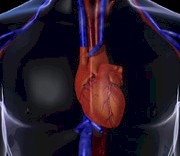Related terms: aortic insufficiency, aortic regurgitation, aortic stenosis
Diseases of the heart valves are grouped according to which valve or valves are involved and the amount of blood flow that is disrupted by the problem. The most common and serious valve problems happen in the mitral and aortic valves.
The aortic valve regulates the blood flow from the heart's lower-left chamber (the left ventricle) into the aorta. The aorta is the main vessel that supplies blood to the rest of the body.
Two diseases of the aortic valve are regurgitation and stenosis.
Aortic regurgitation
Aortic regurgitation is also called aortic insufficiency or aortic incompetence. It is a condition in which blood flows backward from a widened or weakened aortic valve into the heart's lower chamber (the left ventricle). The most serious form of aortic regurgitation is caused by an infection that leaves holes in the valve leaflets. Symptoms of aortic regurgitation may not appear for years. When symptoms do appear, it is because the left ventricle must work harder to make up for the backflow of blood. The ventricle eventually gets larger, causing a backup of fluid.
What causes aortic regurgitation?
Aortic regurgitation is most common in men between the ages of 30 and 60. In adults, the most common cause of severe aortic regurgitation is rheumatic fever. Mild cases are often caused by a bicuspid aortic valve (where the valve has 2 leaflets instead of 3) and severe high blood pressure (a diastolic pressure more than 110 mm Hg). Other causes, though rare, may include
- Marfan syndrome, a connective tissue condition where patients have long bones and very flexible joints.
- Endocarditis.
- Ankylosing spondylitis (arthritis of the spine)
- Dissecting aortic aneurysm.
- Aortic stenosis, a narrowing of the aortic valve that often causes some degree of aortic regurgitation.
What are the symptoms?
Like other valve defects, symptoms may not appear for years. When they do appear, they can come on slowly or suddenly. Symptoms begin because the left ventricle has to work harder. In time, the ventricle gets larger and fluid backs up. Symptoms may include
- Shortness of breath
- Chest pain that gets worse with exercise and goes away with rest
- Swelling in the ankles
- Fatigue
- Fast or fluttering pulse
Severe cases can lead to heart failure. In most of these cases, the aortic valve will eventually need to be replaced.
Aortic Stenosis
Aortic stenosis is a narrowing or blockage of the aortic valve that happens when the valve leaflets become coated with deposits. The deposits change the shape of the leaflets and reduce blood flow through the valve. The left ventricle has to work harder to make up for the reduced blood flow. Over time, the extra work can weaken the heart muscle.
What causes aortic stenosis?
Aortic stenosis is more common among men. Congenital defects (those you are born with) and rheumatic fever are the main causes of aortic stenosis in people under 50. In some cases, people are born with a bicuspid aortic valve, meaning the valve has 2 leaflets instead of 3. This may also cause aortic stenosis. In elderly patients, calcium deposits and the growth of fibrous tissue on the aortic valve can stiffen (sclerosis) and distort the leaflets or cause them to fuse together. This is called calcification, and it can make the different leaflets almost look like a single leaflet. Other causes include a history of other valve diseases, coronary artery disease, or a heart murmur.
What are the symptoms?
People with aortic stenosis may not have symptoms for years. When symptoms do appear, they may include
- Fainting, especially during exercise
- Angina-like chest pain that gets worse with exercise and goes away with rest
- Shortness of breath
- Heart palpitations (the feeling that the heart has skipped a beat)
- Coughing
Patients who have aortic stenosis are advised not to exercise too hard. Those with mild aortic stenosis may not need further treatment beyond regular doctor visits. Surgery to replace the valve is the treatment of choice for people with severe aortic stenosis.
Return to main topic: Valve Disease
See also on this site:
Valve Repair or Replacement Surgery

See on other sites:
MedlinePlus
https://medlineplus.gov/ency/article/000179.htm
Aortic Insufficiency
https://medlineplus.gov/ency/article/000178.htm
Aortic Stenosis
Updated August 2016



